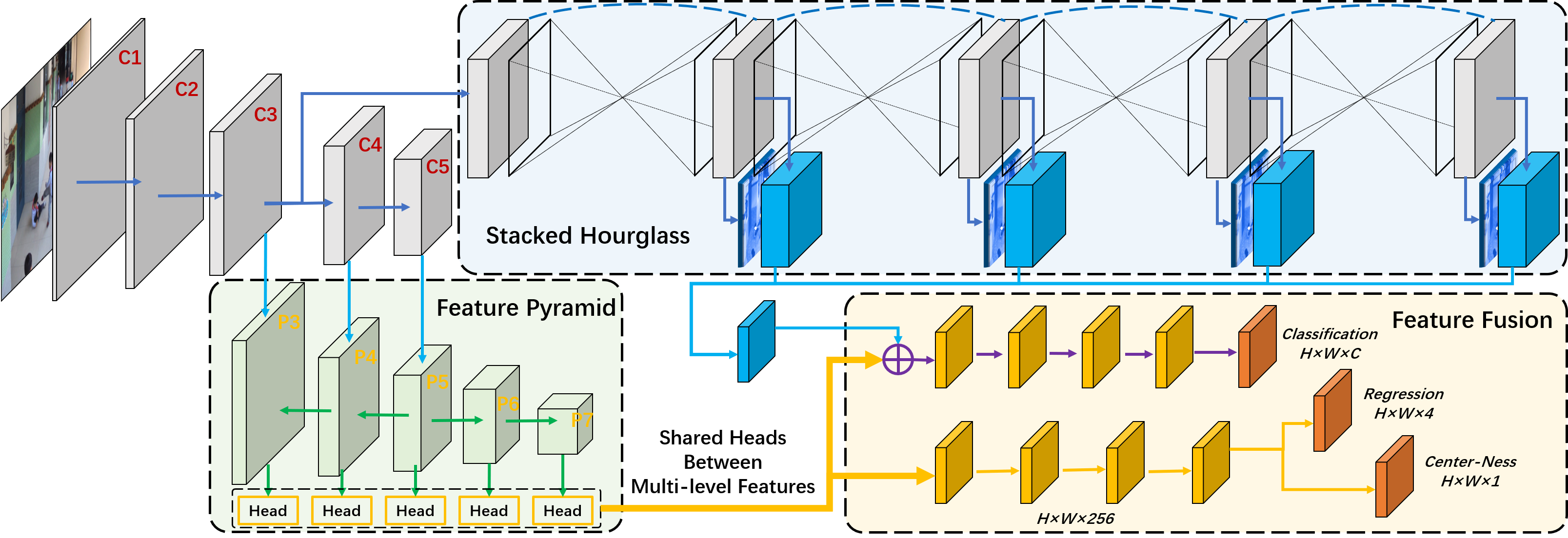Codes for my paper "Student Dangerous Behavior Detection in School". Currently, we have only tested the effectiveness of our method on the personal collected danger behavior dataset. You can build a similar dataset by yourself, and transfer our FCOS_POSE framework based on FCOS (object detection) and auxiliary keypoints (pose estimation) to your human behavior detection task.
Note: Our FCOS_POSE is mostly based on the original object detection method FCOS. You can follow it to set the environment. Our pose estimation backbone is the StackedHourglasses.
Environment: Anaconda, Python3.8, PyTorch1.10.0(CUDA11.2)
$ git clone https://github.com/hnuzhy/fcos_pose.git
$ pip install -r requirements.txt -i https://pypi.tuna.tsinghua.edu.cn/simple
# Codes are only evaluated on GTX3090+CUDA11.2+PyTorch1.10.0. You can follow the same config if needed
# [method 1][directly install from the official website][may slow]
$ pip3 install torch==1.10.0+cu111 torchvision==0.11.1+cu111 torchaudio==0.10.0+cu111 \
-f https://download.pytorch.org/whl/cu111/torch_stable.html
# [method 2]download from the official website and install offline][faster]
$ wget https://download.pytorch.org/whl/cu111/torch-1.10.0%2Bcu111-cp38-cp38-linux_x86_64.whl
$ wget https://download.pytorch.org/whl/cu111/torchvision-0.11.1%2Bcu111-cp38-cp38-linux_x86_64.whl
$ wget https://download.pytorch.org/whl/cu111/torchaudio-0.10.0%2Bcu111-cp38-cp38-linux_x86_64.whl
$ pip3 install torch*.whl
# install the lib with symbolic links
$ python setup.py build develop --no-depsNote: We are sorry that due to privacy issues, our personal dangerous behavior dataset cannot be released for public use. We can only provide an overview of the data set production process.
- Step 1: Collect videos containing dangerous behaviors (e.g.,
fight,tumble, andsquat). Sample frames every N (e.g., 3) seconds. Then, annotate dangerous behaviors with bounding boxes. You can use the popular online annotation tool CVAT. - Step 2: After annotation (about 10K images totally), export your dataset in the
PascalVOCformat (JPEGImagesfolder contains selected frames,Annotationsfolder contains corresponding labels in XML format). - Step 3: Convert the annotations from
PascalVOCXML style toCOCOJSON style. We recommend you to refer the scripts in voc2coco. Support that you finally get two (train and val) json annotation filescoco_dangerdet_train.jsonandcoco_dangerdet_val.json. - Step 4: Generate keypoints for all persons appearing in frames under the
JPEGImagesfolder. We use the robust bottom-up method OpenPifPaf to detect all auxiliary skeletons. Because they are auxiliary labels, the imprecision of keypoints will not affect the normal execution of training. Support that you finally get all keypoints json files under theKeypoints_JSONfolder. - Step 5: Update the json annotation files in Step 3 with adding keypoints information. We provide an example script voc2cocoWpose.py. Finally, you will get two new json annotation files
coco_dangerdet_Wpose_train.jsonandcoco_dangerdet_Wpose_val.json.
Note: Our method is essentially an object detection task. So we still adopt pretrained weights of FCOS. Please refer the official repo to download corresponding models
- Yamls
We put the dataset paths and parameter configs involved in the training in the yaml file. Taking fcos_R_50_FPN_1x_coco_pose2_full.yaml as an example. We only describe the parts that need to be modified.
MODEL:
POSENET_ON: True
FCOS:
NUM_CLASSES: 4 # COCO is 80+1, DangerDet is 3+1
POSENET:
N_STACK: 2 # the num of stacked hourglasses
OUTPUT_DIM: 17 # number of keypoints / heatmaps, COCO:17 MPII:16
FUSE_TYPE: "FULL" # default is "LAST", you can choose "FULL"
DATASETS:
TRAIN: ("coco_dangerdet_Wpose_train",) # all images shape imgh:imgw = 1600:2400 = 2:3
TEST: ("coco_dangerdet_val",) # when testing, we do not need pose labels
INPUT:
MIN_SIZE_TRAIN: (768,) # 1/8 * 1/16, input shape is 768:1152 = 2:3, 768*1/8*1/16 = 6
MAX_SIZE_TRAIN: 1280
MIN_SIZE_TEST: 768
MAX_SIZE_TEST: 1280
SOLVER: # Adjust parameters according to your actual needs
BASE_LR: 0.004 # 0.01
WEIGHT_DECAY: 0.0001
STEPS: (9000, 12000)
MAX_ITER: 15000
CHECKPOINT_PERIOD: 3500
IMS_PER_BATCH: 12 # 16
WARMUP_METHOD: "constant"- Training
Still taking fcos_R_50_FPN_1x_coco_pose2_full.yaml as an example.
CUDA_VISIBLE_DEVICES=2,3 python -m torch.distributed.launch \
--nproc_per_node=2 --master_port=$((RANDOM + 10000)) \
tools/train_net.py \
--config-file configs/danger_det/fcos_R_50_FPN_1x_coco_pose2.yaml \
DATALOADER.NUM_WORKERS 2 \
OUTPUT_DIR training_dir/dangerdet_fcos_R_50_FPN_1x_coco_pose2- Testing
CUDA_VISIBLE_DEVICES=1 python tools/test_net.py \
--config-file configs/danger_det/fcos_R_50_FPN_1x_coco_pose2.yaml \
MODEL.WEIGHT training_dir/dangerdet_fcos_R_50_FPN_1x_coco_pose2/model_final.pth \
TEST.IMS_PER_BATCH 16@article{zhou2022student,
title={Student Dangerous Behavior Detection in School},
author={Zhou, Huayi and Jiang, Fei and Lu, Hongtao},
journal={arXiv preprint arXiv:2202.09550},
year={2022}
}
